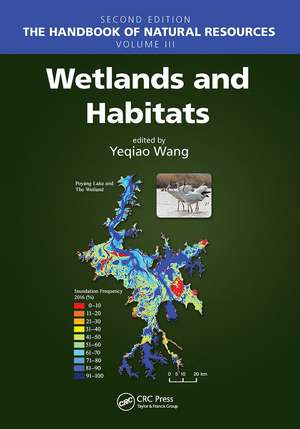Wetlands and Habitats: The Handbook of Natural Resources, Second Edition
Editat de Yeqiao Wangen Limba Engleză Paperback – 9 ian 2023
Volume 3, Wetlands and Habitats, provides fundamental information on wetlands and their integral functions as a productive ecosystem. The topics it covers include wetlands biodiversity, wetlands classification and monitoring, floods, river ecosystems, pollution, and more. New to this edition are discussions on wetland vegetation, assessment of current wetland health status, restoration, sea-level rises and coastal storm, vulnerability to human impacts, and lakes and wetlands remote sensing. This volume demonstrates the key processes, methods, and models used through many case studies from around the world.
Written in an easy-to-reference manner, The Handbook of Natural Resources, Second Edition, as individual volumes or as a complete set, is an essential reading for anyone looking for a deeper understanding of the science and management of natural resources. Public and private libraries, educational and research institutions, scientists, scholars, and resource managers will benefit enormously from this set. Individual volumes and chapters can also be used in a wide variety of both graduate and undergraduate courses in environmental science and natural science at different levels and disciplines, such as biology, geography, earth system science, and ecology.
| Toate formatele și edițiile | Preț | Express |
|---|---|---|
| Paperback (1) | 342.33 lei 3-5 săpt. | +25.46 lei 7-13 zile |
| CRC Press – 9 ian 2023 | 342.33 lei 3-5 săpt. | +25.46 lei 7-13 zile |
| Hardback (1) | 880.05 lei 6-8 săpt. | |
| CRC Press – 10 iun 2020 | 880.05 lei 6-8 săpt. |
Preț: 342.33 lei
Nou
Puncte Express: 513
Preț estimativ în valută:
65.50€ • 68.76$ • 54.37£
65.50€ • 68.76$ • 54.37£
Carte disponibilă
Livrare economică 20 martie-03 aprilie
Livrare express 06-12 martie pentru 35.45 lei
Preluare comenzi: 021 569.72.76
Specificații
ISBN-13: 9781032474380
ISBN-10: 1032474386
Pagini: 294
Ilustrații: 89
Dimensiuni: 178 x 254 x 21 mm
Greutate: 0.53 kg
Ediția:2
Editura: CRC Press
Colecția CRC Press
Seria The Handbook of Natural Resources, Second Edition
ISBN-10: 1032474386
Pagini: 294
Ilustrații: 89
Dimensiuni: 178 x 254 x 21 mm
Greutate: 0.53 kg
Ediția:2
Editura: CRC Press
Colecția CRC Press
Seria The Handbook of Natural Resources, Second Edition
Cuprins
Section I: Riparian Zone and Management 1. Floodplain Management 2. Floods: Riverine 3. Marshes: Salt and Brackish 4. Peatlands 5. Pollution: Nonpoint Source 6. Riparian Wetlands: Mapping 7. Riparian Zones: Groundwater Nitrate (NO3−) Cycling 8. River Delta Processes and Shapes 9. Streams: Perennial and Seasonal 10. Vernal Pool 11. GIS Analysis of Groundwater Salinity 12. Basic Evaluation Units and Physical Structural Integrality in Riparian Zone Evaluation 13. Riparian Zones Evaluation: Remote Sensing Section II: Wetland Ecosystem 14. Cooling Effects of Urban and Peri-Urban Wetlands: Remote Sensing 15. Ecosystem Service Decline in Response to Wetland Loss 16. Wetlands 17. Wetlands: Biodiversity 18. Wetlands: Classification 19. Wetlands: Ecosystems 20. Wetlands: Freshwater 21. Wetlands: Tidal Section III: Wetland Assessment and Monitoring 22. Wetlands: Economic Value 23. Wetlands: Indices of Biotic Integrity 24. Wetlands: Remote Sensing 25. Assessment of Health Status of Lake Wetland by Vegetation-Based Index of Biotic Integrity (V-IBI) 26. Remote Sensing for Wetland Indices 27. Wetland Mapping: Poyang Lake, Remote Sensing 28. Wetland Conservation Efforts and Policy Impacts in China 29. Water Dynamics of Floodpath Lakes and Wetlands: Remote Sensing 30. Water-Level Variation of Poyang Lake: Remote Sensing
Notă biografică
Dr. Yeqiao Wang is a professor at the Department of Natural Resources Science, College of the Environment and Life Sciences, University of Rhode Island. He earned an MS and a PhD in natural resources management & engineering from the University of Connecticut. From 1995 to 1999, he was an assistant professor in the Department of Geography and Department of Anthropology, University of Illinois at Chicago. He has been on the faculty of the University of Rhode Island since 1999. In addition to his tenured position, he held an adjunct research associate position at the Field Museum of Natural History in Chicago. He has also served as a guest professor and an adjunct professor at universities in the U.S. and China. Among his awards and recognitions, Dr. Wang was awarded the prestigious Presidential Early Career Award for Scientists and Engineers (PECASE) by former U.S. President Clinton in 2000. His research projects have been funded by multiple agencies such as NASA, USDA, USDI, USAID, among others, which supported his scientific studies in various regions of the U.S., in East and West Africa, and in various regions in China. Besides peer-reviewed journal publications, Dr. Wang edited Remote Sensing of Coastal Environments and Remote Sensing of Protected Lands published by CRC Press in 2009 and 2010, respectively. He has also authored and edited over 10 scientific books in Chinese.
Descriere
This volume introduces the general concepts and processes used in wetlands and habitats. As an excellent resource for finding basic knowledge on fresh water bodies, new in this edition are discussions on lakes and wetlands remote sensing, their health status, restoration, sea level rises, vulnerability to human impacts and wetland vegetation.






